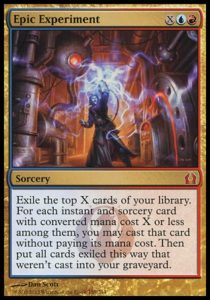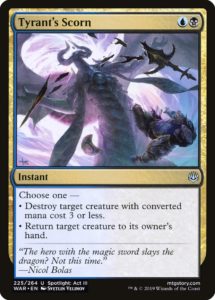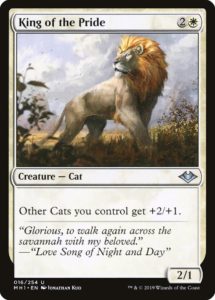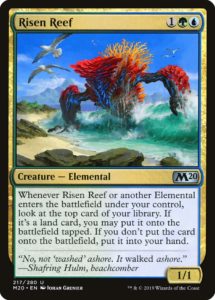The big news from yesterday was the huge changes to the Banned & Restricted lists. Welcome back Rampaging Ferocidon, and welcome to Modern for the first time, Stoneforge Mystic! However, there was another incredibly significant article—Mark Rosewater’s annual State of Design. Magic is an incredibly transparent game in terms of design, and every year MaRo tells the audience at large how the year’s major products were perceived and what was learned. Today, we’ll go over what he said—what was surprising, what was good to hear, and what wasn’t said.
The Year Overall
This point is spot-on. For years, Magic’s complexity kept being over the line. They overcorrected in Ixalan (one of the worst Limited formats this side of Avacyn Restored), and found a solid balance in Dominaria where they used powerful uncommons to increase complexity while keeping commons simple. This year, this trend continued and was aided by an increase in powerful commons, especially in common removal as was seen in War of the Spark.
This lesson isn’t super clear, particularly because of MaRo’s examples. He references the collation technology in War of the Spark—each pack had exactly one Planeswalker (ignoring foils) that appeared at the right rarity slot. This was accomplished without requiring a special slot as seen with Innistrad’s double faced cards and Time Spiral’s Timeshifted sheet. However, I think we saw this exact technique employed last year with Dominaria’s legendary slot.
As I understand it, this may be more about things like Project Booster Fun changing how they approach packaging, product design, and card design, rather than more forward-facing parts of the game. Time will tell, but this being one of the year’s major successes is a bit odd.
This is a design issue caused by the Blockless Paradigm. Even though Magic began this era with a pseudo-block on Ravnica; because none of the sets were drafted together, they had fairly little synergy in Constructed. Core 2020 did a great job of filling in the gaps for decks like Vampires and Dinosaurs and enabling cool new cross-set decks like Scapeshift and GU Flash, but this issue is only going to grow as sets return to being on different planes.
This was arguably the biggest issue with 2018-2019 (and one we’ve addressed). More Magic products are coming out than ever before, but there are still long gaps between some releases and almost nonexistent gaps between others. Guilds of Ravnica and Ravnica Allegiance had more than ample time in the spotlight, but War of the Spark and Modern Horizons stepped on each others’ toes (which then led right into Core 2020 and Commander 2019).
Yes, there is both inertia at hand and strong reasons to keep the major releases when they are—the Fall release is always in late September/early October, which makes sense since doing it earlier would put it in the summer and likely run afoul of school, work, and vacation schedules. But with it being then, it’s hard to do another major release until after the New Year, since that would mean releasing a product right in the middle of the December Christmas rush.
Wait a minute, Ultimate Masters did that! And MaRo said he’d talk about every booster release, yet there’s no mention of Ultimate Masters or Mythic Edition. Turns out, this happened last year:
Booster products with new content. I think my editor snipped out a few words.
— Mark Rosewater (@maro254) August 20, 2018
On one level, this makes sense—Rosewater is reviewing the vision design side of things. All-reprint products aren’t his wheelhouse nearly as much (not to mention he tends not to work on them). Still, it’s unfortunate not to hear about whether Ultimate Masters was considered a success or just how Wizards perceives the bizarre product that is Mythic Edition.
Guilds of Ravnica and Ravnica Allegiance
I agree with MaRo that they did a good job bringing back the ten well-known guilds, that the tone was strong, that there was insufficient innovation, and that the mechanics were good workhorse mechanics, albeit unexciting ones. I feel validated that Ravnica Allegiance had less replayability than Guilds of Ravnica—even though the set had cooler shenanigans, its mechanics being completely modular but nonsynergistic made the format be mostly defined by goodstuff (often Gates) decks rather than have a hodgepodge of archetypes, as Guilds did (even though the green and white decks had issues).
The big question is how Magic will revamp Ravnica when the inevitable fourth return happens (in probably five years or so). There was little innovation this time. Yes, this was necessary, as the sets needed to establish a gloomy twist on the well-known status quo so that War of the Spark could be set on Ravnica without being a typical Ravnica set. But this became a third data point in a somewhat straight line with few surprises: there are so many things we’ve seen all three times we’ve visited the plane (shocklands, common dual lands, common fixing archetypes, guildmages, cycles of cards) that it it’s just hard to both innovate and be true to so many of the build-up expectations. I’m excited to see what they do with Ravnica next time, because I’m really not excited for a fourth return in the vein of Return to Ravnica or Ravnica Allegiance.
War of the Spark
War of the Spark is one of my favorite sets in recent memory (up there with Dominaria). It’s so different from so many other Limited formats, feeling more like a Masters set or Cube than a typical Limited environment. It definitely suffers from having cards like Nissa, Who Shakes the World, Ugin, the Ineffable, and Sarkhan the Masterless at rare, the almost-unanswerable God-Eternal cycle, and too many easy-to-forget Planeswalker static abilities, but I’ll forgive a lot in so cool an experiment. Frankly, the weakest part of the War of the Spark for me is the same weakness that Modern Horizons has—it wasn’t around for nearly long enough.
War of the Spark took years to set up and execute. While I’m sure we can have too many Planeswalker sets, I’m excited to see what the next event set is going to be.
Modern Horizons
While it’s sad to see the Masters product line in retirement, it’s awesome knowing we can have more Masters-esque sets that can also introduce brand new cards (and therefore be commented on in State of Design)! This was an extremely exciting product for Vorthoses, for fans of Magic’s history, and for every nonrotating Constructed format. It provided support for a variety of hard-to-support themes, like slivers, ninjas, and snow, while individual bones to fans of a variety of mechanics, strategies, and lore.
Yes, the product suffered from some messaging issues (the name does not at all communicate that it’s about history and remixing), but I’m surprised that the set is considered such a huge success despite people struggling to be able to play with it. I understand MaRo’s hope that people will play it in between sets (which they can do, since Modern Horizons doesn’t have the limited print run that the Masters sets had), but that’s going to be a hard sell in December (the next anticipated lull, given that spoiler season is about to begin) when the set is six months old.
As with last year, MaRo has less to say about the Core Set (which makes sense, given that he isn’t heavily involved with it). The Limited format has depth to it, but only enough to get me to play it for free on Arena—Core Sets are kind of an off-ramp for a lot of the more enfranchised Limited players I know (which is exacerbated by the complete lack of local competitive Limited events, but that’s a story for another time). The set did a phenomenal job of demonstrating the value of Core Sets to Constructed as well as how much more engaging they can be when they have the amount of story that Magic Origins did.
Overall, the year seemed like a good one for Magic. Whereas 2017-2018 had the high highs of Dominaria Limited and it had the low lows of Ixalan Limited and the downfall of Masters sets, 2018-2019 had fine sets in GRN, RNA, and M20 alongside the powerhouse of War of the Spark (and the popular, but unavailable Modern Horizons).
This was also the year of several administrative shifts. It was the year that Tabletop Magic became one studio (alongside Digital), the year that Project Booster Fun was announced, the year that Magic Arena really took off, the and the inaugural year of the MPL. It was the first year that Play Design had a hand in everything from beginning to end and this seems to have improved things substantially, although it suggests that Play Design might want to turn up the power for green and white in Limited (one of them has been the weakest color in every booster release this year). It was the year that saw enormous changes for competitive Magic, a trend that seems likely to continue next year. It was a year where the playerbase seems to have grown enormously while Grand Prix attendance continued to decline. As ever, these are interesting times to be a Magic player, and it’s fascinating reading not only the candid assessments of Magic’s head designer, but what he does not and cannot comment on.
Here’s looking forward to another year of Magic, some awesome new cards in Throne of Eldraine, and the next innovation product in the vein of Modern Horizons. And, as always, thanks for reading.
—Zachary Barash is a New York City-based game designer and the commissioner of Team Draft League. He designs for Kingdom Death: Monster, has a Game Design MFA from the NYU Game Center, and does freelance game design. When the stars align, he streams Magic (but the stars align way less often than he’d like).
His favorite card of the month is Ill-Gotten Inheritance. It’s not often that you can staple two generally bad effects together and get something powerful, but this unassuming enchantment managed to create an exciting whole out of underwhelming parts. Moreover, it subtly engaged with two very different guilds’ themes while enabling both aggressive and defensive strategies. That’s a lot of work for a pretty straightforward common.









